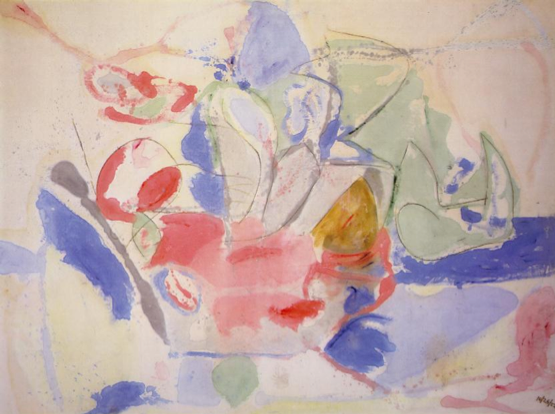"At the age of 23, Helen Frankenthaler painted Mountains and Sea (1952)." This was the opening of The Guardian's obituary for Frankenthaler, who died last week at the age of 83. Later in the obituary, Michael McNay commented that "Her work never departed from the example of Mountains and Sea." Nor was The Guardian's emphasis on Mountains and Sea an anomaly: Grace Glueck's obituary in the New York Times included a colored reproduction of the painting.

Mountains and Sea, Helen Frankenthaler, 1952, National Gallery of Art, Washington
Frankenthaler thus might appear as a classic example of a one-hit wonder, an important artist whose career was dominated by a single early work, joining the long list that includes Mary Shelley, who wrote Frankenstein at 21; Théodore Géricault, who painted The Raft of the Medusa at 28; Paul Sérusier, who painted The Talisman at 25; Grant Wood, who painted American Gothic at 38; Henry Roth, who wrote Call It Sleep at 28; Margaret Mitchell, who wrote Gone with the Wind at 35; Meret Oppenheim who made Le Déjeuner en fourrure at 23; J.D. Salinger, who wrote Catcher in the Rye at 32; Jack Kerouac, who published On the Road at 35; Harper Lee, who wrote To Kill a Mockingbird at 34; Peter Bogdanovich, who directed The Last Picture Show at 32; and Maya Lin, who designed the Vietnam Veterans Memorial at 22.
In fact, however, Frankenthaler doesn't fit neatly into this list. The dozen artists listed above, from Mary Shelley to Maya Lin, were all classic conceptual innovators, who formulated an innovative idea early in their careers, and fully embodied it in the single work with which they are inevitably identified. Frankenthaler's approach to art, in contrast, was decidedly not conceptual: as McNay accurately observed, "She didn't give a fig for theory." She was instead a classic experimental innovator, who valued aesthetic considerations, and worked without preconception toward imprecise visual goals. Yet Frankenthaler's career, with its important early discovery, contrasts sharply with the typical profile of an experimental artist, whose work usually matures gradually, and peaks late in life. Explaining this departure provides an interesting example of the importance of seeing an artist's work within its full historical context.
When Frankenthaler arrived in New York after graduating from college, she quickly came under the tutelage of the prominent critic Clement Greenberg, who was the leading advocate of the Abstract Expressionists in general, and of Jackson Pollock in particular. Under his guidance, Frankenthaler was electrified by Pollock's radical drip technique: she later described her reaction to seeing his works in 1951 "as if I suddenly went to a foreign country but didn't know the language, but had read enough and had a passionate interest, and was eager to live there. I wanted to live in this land; I had to live there, and master the language."
The next year, after a trip to Nova Scotia with Greenberg, Frankenthaler painted Mountains and Sea. She departed from her earlier method of painting on sized and primed canvas, instead following Pollock's practice of laying unstretched raw canvas on the floor. She then poured thinned pigment directly onto the cotton duck: "I wanted to draw in with color and shape the totally abstract memory of the landscape." The diluted pigment soaked into the canvas, creating an effect different from Pollock's, closer to water color than oil painting.
Greenberg immediately considered Mountains and Sea an important new development. Early in 1953, he invited a number of artists to Frankenthaler's studio to see it, including two painters who were visiting New York from Washington, D.C. Both were immediately inspired by the painting. Thus Kenneth Noland remembered that "The painting was big, loose, open, the color spread out, stained in so it would impregnate the weave. We went back to Washington high... The idea was to get free of old ways." Noland's Washington colleague, Morris Louis, described Mountains and Sea as "a bridge between Pollock and what was possible."
Noland and Louis wasted little time adapting Frankenthaler's stain painting technique to their own purposes, and in this way became leaders of what became known as color-field painting. Importance in art is a function of influence, and Frankenthaler's place as the inspiration for of color-field abstraction is secure: as McNay wrote last week, it was "the next big thing in American painting." Greenberg played a significant role in the ascendancy of color-field: he hailed it as the most important art of the 1960s, and his disciple Michael Fried declared that it was no less than the discovery "in which painting itself broke through to its future." Greenberg thus not only placed Frankenthaler in a position to make her artistic innovation, but he helped make her work an influence on other artists, and he helped in turn to make their work well known. His unusual position and actions appear to have made possible the anomaly of an experimental artist becoming a one-hit wonder.
Frankenthaler's key role in the development of color-field painting is recognized in the New York Times' headline describing her as "Abstract Painter Who Shaped a Movement." Her place in art history would be much greater than it is in fact had color-field abstraction genuinely become the painting of the future. But it did not: its leading position proved short-lived. Instead, in spite of the rhetorical efforts of Greenberg and Fried, in the early 1960s Pop Art quickly displaced color-field abstraction as the dominant art of its time. Today, Andy Warhol, Roy Lichtenstein, and their Pop colleagues loom much larger in narratives of art history than Frankenthaler, for they were the artists who became the greatest influences on the advanced art of the late 20th century and beyond. Yet thanks in large part to the efforts and influence of Clement Greenberg, Helen Frankenthaler became a one-hit wonder: Mountains and Sea today hangs in Washington's National Gallery, and serves as the single minor masterpiece that signifies Frankenthaler's place in art history.
